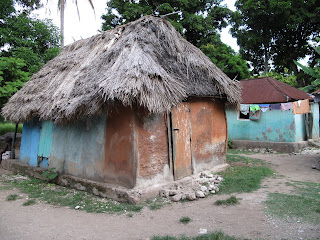
Coat of arms of Haiti

History
On January 12, 2010, a 7.0 magnitude earthquake struck Haiti and devastated the capital city, Port-au-Prince. Reportedly more than 150,000 people were killed and the Presidential palace, Parliament and many other important structures were destroyed, along with countless homes and businesses.
The Republic of Haiti along with the Dominican Republic share the island of Hispaniola, in the Greater Antillean archipelago. Haiti (land of high mountains) was the indigenous Taíno or Amerindian name for the mountainous western side of the island. When the French government changed, new members of the national legislature –lobbied by planters – began to rethink their decisions on colonial slavery. After Toussaint l'Ouverture created a separatist constitution, Napoléon Bonaparte sent an expedition of 20,000 men under the command of his brother-in-law, General Charles Leclerc, to retake the island. Leclerc's mission was to oust l'Ouverture and restore slavery. The French achieved some victories, but within a few months, yellow fever had killed most of the French soldiers. Leclerc invited Toussaint l'Ouverture to a parley, kidnapped him and sent him to France, where he was imprisoned at Fort de Joux. He died there in 1803 of exposure and tuberculosis or malnutrition and pneumonia. In its attempt to retake the colony, France had lost more than 50,000 soldiers, including 18 generals. Slaves, free gens du couleur and allies continued their fight for independence after the French transported l'Ouverture to France. The native leader Jean-Jacques Dessalines – long an ally and general of Toussaint l'Ouverture – defeated French troops led by Donatien-Marie-Joseph de Vimeur, vicomte de Rochambeau, at the Battle of Vertières. At the end of the double battle for emancipation and independence, former slaves proclaimed the independence of Saint-Domingue on 1 January 1804, declaring the new nation be named Haïti, to honor one of the indigenous Taíno names for the island.
Map of Haiti

Geography
Haiti is situated on the western part of Hispaniola, the second largest island in the Greater Antilles. Haiti is the third largest country in the Caribbean behind Cuba and the Dominican Republic (the latter shares a 360 kilometer (224 mi) border with Haiti). Haiti at its closest point is only about 45 nautical miles (80 km; 50 mi) away from Cuba and has the second longest coastline (1,771 km/1,100 mi) in the Greater Antilles, Cuba having the longest. Haiti's terrain consists mainly of rugged mountains interspersed with small coastal plains and river valleys.
The northern region consists of the Massif du Nord (Northern Massif) and the Plaine du Nord (Northern Plain). The Massif du Nord is an extension of the Cordillera Central in the Dominican Republic. It begins at Haiti's eastern border, north of the Guayamouc River, and extends to the northwest through the northern peninsula.
The southern region consists of the Plaine du Cul-de-Sac (the southeast) and the mountainous southern peninsula (also known as the Tiburon Peninsula). The Plaine du Cul-de-Sac is a natural depression that harbors the country's saline lakes, such as Trou Caïman and Haiti's largest lake, Lac Azuei. The Chaîne de la Selle mountain range – an extension of the southern mountain chain of the Dominican Republic (the Sierra de Baoruco)
Departments
Haiti is divided into ten departments. The departments are listed below, with the departmental capital cities in parentheses.
1- Artibonite (Gonaïves)
2- Centre (Hinche)
3- Grand'Anse (Jérémie)
4- Nippes (Miragoâne)
5- Nord (Cap-Haïtien)
6- Nord-Est (Fort-Liberté)
7- Nord-Ouest (Port-de-Paix)
8- Ouest (Port-au-Prince)
9- Sud-Est (Jacmel)
10- Sud (Les Cayes)
Map of Haiti's departments





















































